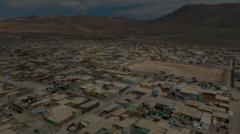In the arid landscape of Alto Hospicio, where average yearly rainfall barely reaches 5mm, the local populace has been grappling with severe water scarcity, particularly in slum areas where access to municipal water supplies is non-existent. A recent study led by Dr. Virginia Carter Gamberini from Universidad Mayor has spotlighted fog harvesting as a solution to this pressing issue.
Fog harvesting systems operate on a simple principle: a fine mesh is suspended between poles to capture droplets from passing moisture-laden fog. As these clouds pass through the mesh, water condenses and flows into pipes and storage tanks. This method of water collection is not entirely new; small-scale implementations have thrived in rural parts of South and Central America where fog conditions are favorable. One of the largest systems is found at the edge of the Sahara Desert in Morocco.
However, the need for large-scale fog harvesting has become apparent in urban areas experiencing rapid growth. The researchers conducted extensive assessments to gauge the volume of water that could be harvested from prevailing fog conditions. They concluded that the abundant fog above Alto Hospicio could provide significant water resources for its slum neighborhoods.
Their findings reveal that a mesh area of just 17,000 square meters could yield enough water to meet the weekly demand of 300,000 liters presently supplied by water trucks, while a mere 110 square meters could fulfill the irrigation needs for the city’s green spaces. The team also highlighted the opportunity for hydroponic agriculture, suggesting that fog-harvested water could foster crop yields of up to 44 pounds of vegetables monthly.
Alto Hospicio is nestled against the Atacama Desert, one of Earth’s driest regions. With dwindling fresh water sources and increasing pressures from urban population growth and resource extraction, sustainable alternatives like fog harvesting are becoming increasingly vital. Dr. Gamberini emphasized Chile's unique geographic advantages, stating its extensive coastline and mountain ranges contribute to favorable fog conditions.
In pursuit of wider applications, the research team is in the process of developing a fog harvesting map to identify potential locations across the nation. Dr. Carter envisions that “water from the clouds” could not only alleviate water scarcity but also fortify cities against the impacts of climate change, promising a rejuvenation of hope for impoverished communities facing dire ecological challenges.
Fog harvesting systems operate on a simple principle: a fine mesh is suspended between poles to capture droplets from passing moisture-laden fog. As these clouds pass through the mesh, water condenses and flows into pipes and storage tanks. This method of water collection is not entirely new; small-scale implementations have thrived in rural parts of South and Central America where fog conditions are favorable. One of the largest systems is found at the edge of the Sahara Desert in Morocco.
However, the need for large-scale fog harvesting has become apparent in urban areas experiencing rapid growth. The researchers conducted extensive assessments to gauge the volume of water that could be harvested from prevailing fog conditions. They concluded that the abundant fog above Alto Hospicio could provide significant water resources for its slum neighborhoods.
Their findings reveal that a mesh area of just 17,000 square meters could yield enough water to meet the weekly demand of 300,000 liters presently supplied by water trucks, while a mere 110 square meters could fulfill the irrigation needs for the city’s green spaces. The team also highlighted the opportunity for hydroponic agriculture, suggesting that fog-harvested water could foster crop yields of up to 44 pounds of vegetables monthly.
Alto Hospicio is nestled against the Atacama Desert, one of Earth’s driest regions. With dwindling fresh water sources and increasing pressures from urban population growth and resource extraction, sustainable alternatives like fog harvesting are becoming increasingly vital. Dr. Gamberini emphasized Chile's unique geographic advantages, stating its extensive coastline and mountain ranges contribute to favorable fog conditions.
In pursuit of wider applications, the research team is in the process of developing a fog harvesting map to identify potential locations across the nation. Dr. Carter envisions that “water from the clouds” could not only alleviate water scarcity but also fortify cities against the impacts of climate change, promising a rejuvenation of hope for impoverished communities facing dire ecological challenges.




















